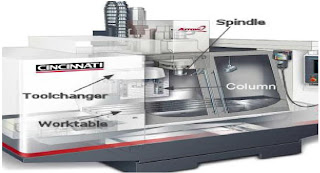Not all cutting operations take place in either a vertical or horizontal direction. A CNC machine will often be required to cut along a diagonal line. This movement is called linear interpolation. To make this cut, a CNC machine moves on two axes simultaneously. Figure 1 shows a diagonal cut along the X- and Y-axes.
Now imagine that the same diagonal cut needed to be made, except that the cutting tool must gradually lift off the table as well. This cutting operation would require movement on the X-, Y-, and Z-axes simultaneously. Figure 2 shows another type of simultaneous movement along three axes.
Sophisticated CNC machines can move a tool along two or more axes at once. This movement allows a machine to perform contouring. Contour movements can produce curves, circles, and even cones, like those shapes in Figure 3. However, very few CNC systems factor all six axes at once during their operations, and many only address two or three axes at the same time.
Now imagine that the same diagonal cut needed to be made, except that the cutting tool must gradually lift off the table as well. This cutting operation would require movement on the X-, Y-, and Z-axes simultaneously. Figure 2 shows another type of simultaneous movement along three axes.
Sophisticated CNC machines can move a tool along two or more axes at once. This movement allows a machine to perform contouring. Contour movements can produce curves, circles, and even cones, like those shapes in Figure 3. However, very few CNC systems factor all six axes at once during their operations, and many only address two or three axes at the same time.



































